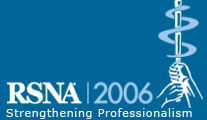
Abstract Archives of the RSNA, 2006
SSG17-02
Evaluation of a Kymogram-based Phase-Correlated Cardiac Image Reconstruction Using a Dual-Source CT
Scientific Papers
Presented on November 28, 2006
Presented as part of SSG17: Physics (CT: New Systems)
Dirk Ertel, Presenter: Nothing to Disclose
Marc Kachelriess PhD, Abstract Co-Author: Nothing to Disclose
Michael Knaup PhD, Abstract Co-Author: Nothing to Disclose
Willi A. Kalender PhD, Abstract Co-Author: Consultant, Siemens AG
Founder, VAMP GmbH
Scientific Advisor, VAMP GmbH
Shareholder, VAMP GmbH
To generate a rawdata-based synchronization signal for a dual-source CT scanner and to compare it to the commonly used ECG.
The kymogram represents a motion function which is correlated to the heart rate; it is generated by a center-of-mass tracking of the scanned object [Med. Phys., 29 (7):1489-1503, 2002]. We evaluated this purely rawdata-based synchronization signal as an alternative to the ECG signal for phase-correlated image reconstruction using a dual-source CT scanner (SOMATOM Definition, Siemens, Forchheim). For evaluation data of 15 patients were used, scanned with 2·64 slices of 0.6 mm (2 sources, 2 FFS positions, 32 rows), 0.33 s rotation time and concurrent ECG recording. The kymogram function was computed by using the rawdata acquired by both sources as well as by only 1 source. As a quality measure the correlation of the ECG with the kymogram was used for validation. The goal was to assess the signal quality by itself as well as the potential improvement by using a dual-source CT instead of an equivalent single-source CT system.
For 12 out of 15 patients a high correlation between the kymogram and the ECG was observed with a mean difference of the detected heart rate below 4 bpm. In comparison to the kymogram generated with a single source synchronization signals with higher temporal resolution were obtained for the dual-source system indicated by a lower difference of the detected heart rate of 20%. For all patients we were able to achieve a good quality in the cardiac images using a kymogram-based phase-correlated reconstruction and improved image quality in some cases.
We conclude that the newest generation of DSCT scanners may provide advantages for a kymogram-based phase-correlated image reconstruction compared to single source systems.
The kymogram function provides an ECG-independent cardiac image reconstruction and shows the true mechanical contraction of the heart instead of an indirect signal like the ECG.
Ertel, D,
Kachelriess, M,
Knaup, M,
Kalender, W,
Evaluation of a Kymogram-based Phase-Correlated Cardiac Image Reconstruction Using a Dual-Source CT. Radiological Society of North America 2006 Scientific Assembly and Annual Meeting, November 26 - December 1, 2006 ,Chicago IL.
http://archive.rsna.org/2006/4428343.html

